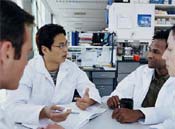RESEARCH AND MARKET EXPRESS
Cinnamon may help to alleviate Diabetes
Peter Ou, Ph.D.Cinnamon May Help to Alleviate Diabetes Says UCSB Researcher
April 12, 2004
(Santa Barbara, Calif.) – Cinnamon may be more than a spice – it may have a medical application in preventing and combating diabetes. Cinnamon may help by playing the role of an insulin substitute in type II diabetes, according to cellular and molecular studies at the University of California, Santa Barbara, Iowa State University and the U.S. Department of Agriculture.
"Cinnamon itself has insulin-like activity and also can potentiate the activity of insulin," said Don Graves of UCSB. "The latter could be quite important in treating those with type II diabetes. Cinnamon has a bio-active component that we believe has the potential to prevent or overcome diabetes."
The healthful effects of cinnamon on mice with diabetes are being studied in a joint project at the UCSB and the Sansum Diabetes Research Institute in Santa Barbara.
The researchers have been studying the effects of cinnamon on obese mice, which have been fed water laced with cinnamon at Sansum's lab, according to Graves, who is running the project with Lois Jovanovic, Sansum's research director.
When the trials are completed, 60 diabetic mice will have been studied, sponsored by a grant to UCSB from Cottage Hospital, Santa Barbara. The study began six months ago and final results are expected in about six months.
"More than 170 million people worldwide suffer from diabetes, and for many, drugs or other forms of treatment are unavailable," said Graves. "It may be possible that many of these people could benefit from readily available natural products such as cinnamon."
Graves, an adjunct professor of Molecular, Cellular and Developmental Biology, retired from Iowa State University in October 2000 and came to UCSB the same month. He was familiar with UCSB from his days as a visiting professor in the Department of Chemistry during the 1970s and decided to return. He now divides his time between UCSB and the Sansum Institute.
Using nuclear magnetic resonance and mass spectroscopy, the researchers obtained results which allowed them to describe the chemical structure of a molecule with "insulin-like" activity in cinnamon. Graves and others reported earlier that this compound, a proanthocyanidin, can affect insulin signaling in fat cells.
Richard Anderson of the U.S. Department of Agriculture, a former Graves student and the discoverer of the insulin-like activity, recently completed a human study with associates in Pakistan using cinnamon. Promising results were obtained by 30 test subjects with type II diabetes after only 40 days of taking cinnamon. They had a significant decrease in blood glucose, triglycerides, LDL, and cholesterol. The researchers hope that a human trial may begin in the US, possibly in Santa Barbara, using cinnamon and its water-soluble extract to treat type II diabetes.
Type II diabetes is a disease in which the body develops a resistance to insulin, thus preventing the cells from receiving the glucose that they need to function. The work at UCSB is focused on the way cinnamon operates at cellular and molecular levels, looking at how it works with the cell's insulin receptor and other proteins involved in reactions associated with the action of insulin.
Graves said that other major diseases could possibly be helped by cinnamon. For example one prospect is pancreatic cancer, a disease in which abnormal amounts of insulin are produced by the pancreas in response to the cancer tumor causing insulin resistance in the cells of the body. The resistance prevents glucose availability to the cells. Graves believes that cinnamon might help overcome this resistance. "It's speculative but exciting," he said.
Recent studies have shown that insulin resistance may also be involved in neurodegenerative diseases such as Alzheimer's, according to Graves. A study testing the effects of the "insulin-like" component of cinnamon on protein reactions associated with Alzheimer's disease is planned at UCSB's Neuroscience Research Institute (NRI). Graves is working in the NRI lab of John Lew, who studies Alzheimer's disease.
Graves calls himself a "scientific grandfather" to Lew, since Lew's major professor, Jery Wang, was a Ph.D. student of Graves at Iowa State University in 1961. Wang later became Lew's major professor at the University of Calgary.
Scientists at the Agricultural Research Service (ARS) began studies on cinnamon ten years ago. It was then found to make fat cells much more responsive to insulin (that's positive.) They are still working on an ingredient in the plant, but have already found that this substance (MHCP,) prevented the formation of "damaging oxygen radicals...."
As Dr. Richard A. Anderson of ARS states, "[it] could be an important side effect, [since] other studies have shown that antioxidant supplements can reduce or slow the progression of various complications of diabetes."
This MHCP ingredient, the ARS found, is water soluble and is not found in the spice oils sold as food additives. Anderson added that this substance reduced blood pressure in animals with high pressure readings.
NOTE: The way to use it, it would seem, is to buy sticks of cinnamon, grind it if you can and add it to bread recipes and as a tea with sugar.
Go back
